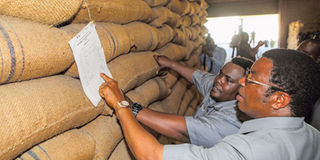Act over drought threat, govt urged

Dar es Salaam. The government should urgently evaluate the impact of drought and make short, medium and long-term interventions to save people’s lives, agriculture stakeholders have suggested.
Measures should include supplying relief food to households worst affected by food shortages, supplying more food to the market to stabilise prices, restricting cereal exports and importing cereals to boost National Food Reserve Authority (NFRA) stocks.
The proposals followed reports that drought has killed more than 3,800 livestock in Kilosa District, Morogoro Region, and was being felt in several other regions.
Reports from Manyara Region said Kiteto District was grappling with acute an food shortage that had prompted District Commissioner Simon Chacha to direct that 500 tonnes of cereals be sold to residents at affordable prices.
Mr Chacha told reporters earlier this week that crops had dried up and there was a shortage of pasture for livestock.
This, in turn, has led to panic selling of livestock, causing prices to crash. At the beginning of the week cattle were being sold for Sh200,000 each, down from Sh400,000, while goats went for Sh40,000 each instead of Sh120,000. Chicken prices have dropped to an average of Sh4,000 per bird from Sh15,000.
In Dar es Salaam, a kilogramme of maize flour was retailing at between Sh1,400 and Sh1,700 this week, up from Sh1,200 a month ago.
Agricultural Non-State Actor Forum (Ansaf) Executive Director Audax Rukonge advised the government to evaluate the drought situation at district and regional levels to have an accurate picture of the food situation and take the necessary precautionary and remedial measures.
“Government leaders should not hesitate to declare famine in their respective areas. Regional food capacities should be evaluated regardless of the amount of food currently held in the national reserve,” he told The Citizen in a telephone interview.
He added that such an evaluation would make it possible to determine whether there was a need to import cereals or ask the private sector not to export grain and sell it domestically instead.
As for medium and long-term interventions, Mr Rukonge said the government should promote irrigation farming as that would guarantee good harvests even during periods of adverse weather.
“It is time Tanzania made the best use of the over 29 million hectares that is suitable for irrigation farming. This land is currently grossly under-utilised,” he said.
Dr Anna Temu of the Sokoine University of Agriculture also appealed to the government to establish losses incurred by farmers due to the current unfavourable weather.
“Losses have been incurred in preparation of farms and sowing of seeds, which have been lost...the government should consider this a disaster because farmers have lost seeds and now face an acute food shortage,” she said in a telephone interview.
Evergreen Agriculture Tanzania Executive Director Deusdedit Kiiza said the government should release food from the national reserve to stabilise skyrocketing cereal prices.
“If there isn’t enough food in reserve, the government should facilitate importation of cereals as a matter of urgency,” he said.
But the Minister of Agriculture, Livestock and Fisheries, Dr Charles Tizeba, assured the public that the country had enough food that could last more than a month.
He was reacting to remarks by Alliance for Change and Transparency (ACT-Wazalendo) party leader Zitto Kabwe, who said the country had food reserves that could last less than ten days.
“I can’t disclose the amount of stocks held by NFRA for security reasons, but I want to assure the public that there is enough food to last more than month, not eight days as claimed by the opposition leader,” he said.
However, the Bank of Tanzania’s latest monthly economic review shows that NFRA had 90,476 tonnes of cereals at the end of October 2016 compared with 253,655 tonnes as of October 31, 2015.
Fears of famine were heightened when the Tanzania Meteorological Agency announced that the country received below-average rainfall in November and December, last year.
Tanga, Coast, Dar es Salaam, Morogoro and Zanzibar received “very little or no rain ”. Kilimanjaro, Arusha and Manyara regions received occasional rain showers, mainly over high grounds, while low-lying areas received average or below-average rainfall, the agency said on its website.
The remaining areas, including the Lake Victoria basin regions, western regions, central regions and southern highlands regions, received below-average rainfall during the two months when farmers usually sow.
TMA said there was a high possibility of inadequate harvests this year due to the rainfall shortage.
In a report published last month, the Famine Early Warning System Network (FEWS-NET) warned of the consequences of delayed onset and below-average short rains expected between mid-September and December and slow or below-average long rains.
“They will likely cause deterioration in food security for poor households, reduced labour opportunities, coupled with rising food prices, likely to constrain purchasing capacities and food access,” the report says.




